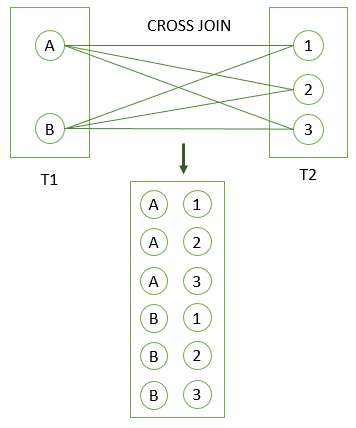PostgreSQL Cross Join
Summary: in this tutorial, you will learn how to use the PostgreSQL CROSS JOIN to produce a cartesian product of rows from the joined tables.
Introduction to the PostgreSQL CROSS JOIN clause
In PostgreSQL, a cross-join allows you to join two tables by combining each row from the first table with every row from the second table, resulting in a complete combination of all rows.
In the set theory, we can say that a cross-join produces the cartesian product of rows in two tables.
Unlike other join clauses such as LEFT JOIN or INNER JOIN, the CROSS JOIN clause does not have a join predicate.
Suppose you have to perform a CROSS JOIN of table1 and table2.
If table1 has n rows and table2 has m rows, the CROSS JOIN will return a result set that has nxm rows.
For example, the table1 has 1,000 rows and table2 has 1,000 rows, the result set will have 1,000 x 1,000 = 1,000,000 rows.
Because a CROSS JOIN may generate a large result set, you should use it carefully to avoid performance issues.
Here’s the basic syntax of the CROSS JOIN syntax:
SELECT
select_list
FROM
table1
CROSS JOIN table2;The following statement is equivalent to the above statement:
SELECT
select_list
FROM
table1,table2;Alternatively, you can use an INNER JOIN clause with a condition that always evaluates to true to simulate a cross-join:
SELECT
select_list
FROM
table1
INNER JOIN table2 ON true;PostgreSQL CROSS JOIN example
The following CREATE TABLE statements create T1 and T2 tables and insert sample data for the cross-join demonstration.
DROP TABLE IF EXISTS T1;
CREATE TABLE
T1 (LABEL CHAR(1) PRIMARY KEY);
DROP TABLE IF EXISTS T2;
CREATE TABLE
T2 (score INT PRIMARY KEY);
INSERT INTO
T1 (LABEL)
VALUES
('A'),
('B');
INSERT INTO
T2 (score)
VALUES
(1),
(2),
(3);The following statement uses the CROSS JOIN operator to join T1 table with T2 table:
SELECT *
FROM T1
CROSS JOIN T2;label | score
-------+-------
A | 1
B | 1
A | 2
B | 2
A | 3
B | 3
(6 rows)The following picture illustrates how the CROSS JOIN works when joining the T1 table with the T2 table:

Some practical examples of using CROSS JOIN
In practice, you can find the CROSS JOIN useful when you need to combine data from two tables without specific matching conditions. For example:
1) Scheduling
Suppose you have a table for employees and shifts, and you want to create a schedule that lists all possible combinations of employees and shifts to explore various staffing scenarios:
SELECT *
FROM employees
CROSS JOIN shift;2) Inventory management
In an inventory management system, you have tables for warehouses and products. A CROSS JOIN can help you analyze the availability of each product in every warehouse:
SELECT *
FROM products
CROSS JOIN warehouses;Summary
- Use the PostgreSQL
CROSS JOINclause to make a cartesian product of rows in two tables.